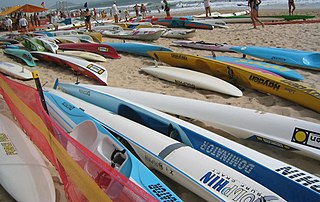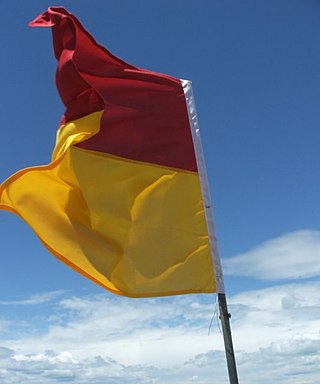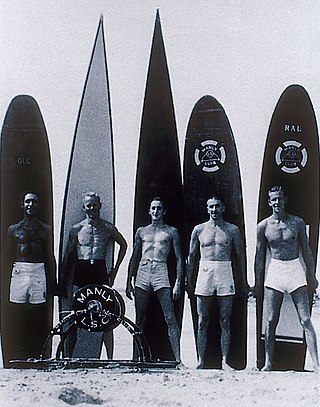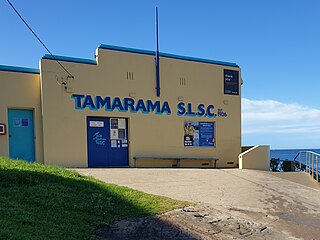
Darwin is the capital city of the Northern Territory, Australia. With a population of 139,902 at the 2021 census, the city contains most of the sparsely populated Northern Territory's residents. It is the smallest, wettest, and most northerly of the Australian capital cities and serves as the Top End's regional centre.

Surf lifesaving is a multifaceted social movement that comprises key aspects of voluntary lifeguard services and competitive surf sport. Originating in early 20th century Australia, the movement has expanded globally to other countries, including New Zealand, Ireland, South Africa, and the United Kingdom. Surf lifesavers in Australia are colloquially known as "Clubbies".
Casuarina is one of the northern suburbs of Darwin, the capital of the Northern Territory of Australia. It is the traditional country and waterways of the Larrakia people.
Surf Life Saving Northern Region is the largest of four regions that make up Surf Life Saving New Zealand. As of the 2021/2022 season, it is made up of 18 clubs that look after 22 patrol locations from Ahipara to Raglan on the West Coast and from Whangārei Heads to Takapuna on the East Coast.

Surf Life Saving New Zealand (SLSNZ) is the national association representing 74 Surf Life Saving Clubs in New Zealand. The organisation's motto is 'In it for Life'. This refers to both the long relationship many members have with the organisation, as well as to the organisation's purpose of preventing drowning and injury, thereby saving lives.

Surf Life Saving Clubs are volunteer institutions at Australia's beaches. The clubs conduct surf lifesaving services on weekends and public holidays, and in the 2014-2015 season they saved 12,690 people. They also host many beach sport activities, such as Nippers, surf carnivals and other competitions. The SLSCs are responsible for the education of Lifesavers including operation of Inflatable Rescue Boats (IRBs) and maintaining radio communication with other beaches and air rescue resources.

The Manly Life Saving Club is one of Australia's oldest Surf Life Saving Clubs, founded in 1911; located in the Sydney suburb of Manly, in the Northern Beaches Council in New South Wales.

Cronulla Beach, is a patrolled beach on Bate Bay in the Sydney suburb of Cronulla, New South Wales, Australia. The Cronulla Pavilion and the Cronulla Lifesaving Club are two prominent buildings located close to the sand. Cronulla Park sits behind the beach. The Cronulla Rock Pools are between Cronulla Beach and North Cronulla beach. The Alley is the local name given to the area between Cronulla Beach and North Cronulla Beach. Shark Island is a dangerous reef break, located off Cronulla Beach.

The International Life Saving Federation (ILS) is an organisation for drowning prevention, water safety, lifesaving and lifesaving sports.

The Coogee Surf Life Saving Club is a foundation member of the surf lifesaving movement in Australia. It was founded in 1907 by a group of concerned locals and has a proud history of no lives being lost whilst its members have patrolled. Coogee SLSC celebrated its 100-year anniversary in 2007, the Year of the Lifesaver.

The Royal Life Saving Society Canada, commonly known as the Lifesaving Society or LSS, is a Canadian registered charity that works to prevent water-related injuries through various programs across Canada. The Lifesaving Society is an independent organization that is composed of ten provincial/territorial branches, tens of thousands of individual members, and over 4,000 affiliated swimming pools, waterfronts, schools and clubs. The Society helps prevent drowning and aquatic injury through its training programs, public education, drowning-prevention research, safety management and overseeing the sport of lifesaving. They are one of five recognized first aid training organizations in Canada, alongside the Heart and Stroke Foundation, Red Cross, St. John Ambulance, and the Canadian Ski Patrol.
The Royal Life Saving Society of Australia (RLSSA) is a water safety, swimming and lifesaving education organisation in Australia. RLSSA provides courses in water safety, lifesaving and resuscitation.

Surf Life Saving Australia (SLSA) is an Australian not-for-profit community organisation that promotes water safety and provides surf rescue services.

Lifesaving is the act involving rescue, resuscitation and first aid. It often refers to water safety and aquatic rescue; however, it could include ice rescue, flood and river rescue, swimming pool rescue and other emergency medical services. Lifesaving also refers to sport where lifesavers compete based on skills, speed and teamwork. Lifesaving activities specialized in oceanic environment is called surf lifesaving or coastal lifesaving.
The club was founded in 1903 and the movement has since spread to other parts of New South Wales and the rest of the country. The club rests on indigenous land and whilst there is no clear evidence for the name or names of the Eora people who lived in what is now the Waverley area, most sources agree on the Cadigal, but some sources name the Biddigal and Birrabirragal bands as well.
The North Bondi Surf Life Saving Club is a foundation member of the surf lifesaving movement in Australia. It was founded in 1907 by a group of concerned locals and has a proud history of no lives being lost whilst its members have patrolled.
The Maroubra Surf Life Saving Club is one of Australia's oldest Surf Life Saving Clubs, founded in 1906. The club was established in 1906 the Club is situated at the northern end of Maroubra Beach in Sydney.

The Tamarama Surf Life Saving Club was founded in 1906 and operates at Tamarama Beach, Sydney. The clubhouse sits at the northern end of the beach.
The Australian Surf Life Saving Championships known as The Aussies is the national Surf lifesaving championships for Australia. It is the largest surf lifesaving event in Australia and the largest event of its kind in the world. It is organised by the Surf Life Saving Australia, and had been held annually since 1915.











